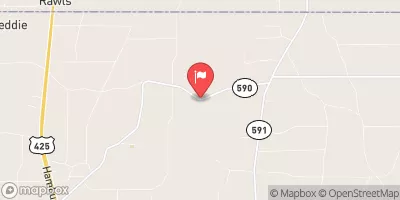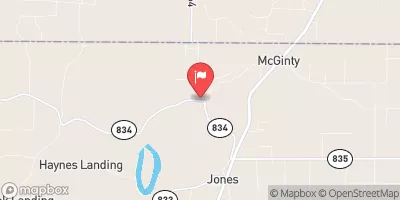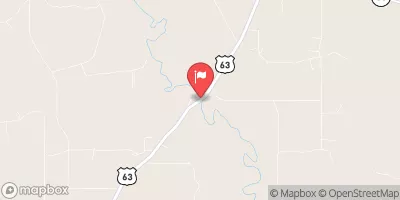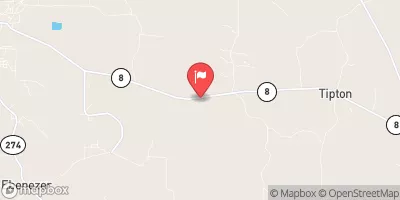Lake Georgia-Pacific Dam Reservoir Report
Nearby: Mill Pond Dam Lucas Pond Dam
Last Updated: December 18, 2025
Lake Georgia-Pacific Dam, located in Ashley County, Arkansas, was completed in 1963 for the primary purpose of irrigation.
°F
°F
mph
Wind
%
Humidity
Summary
This private earth dam stands at a height of 20 feet and has a hydraulic height of 16 feet, with a length of 26,380 feet. The dam has a normal storage capacity of 12,250 acre-feet and a maximum storage capacity of 18,635 acre-feet, covering a surface area of 1,725 acres.
The dam, situated on the Saline River, is classified as having low hazard potential and is currently not rated for its condition. While it has not been inspected since 1990, the dam is not subject to state regulation, permitting, inspection, or enforcement. The lack of federal agency involvement in the management of Lake Georgia-Pacific Dam highlights the importance of private ownership in water resource infrastructure, especially in the context of irrigation and agricultural water supply in the region.
Despite its lack of recent inspection and assessment, Lake Georgia-Pacific Dam remains a vital component of the local water resource infrastructure, serving the agricultural community in Ashley County. The dam's construction and purpose underscore the significance of private investment and ownership in maintaining and managing water resources for irrigation and other essential uses in the region.
Dam Height |
20 |
Hydraulic Height |
16 |
Drainage Area |
3.1 |
Year Completed |
1963 |
Structural Height |
18 |
Nid Storage |
18635 |
Surface Area |
1725 |
River Or Stream |
SALINE RIVER-TR |
Dam Length |
26380 |
Hazard Potential |
Low |
Primary Dam Type |
Earth |
Nid Height |
20 |
Seasonal Comparison
Weather Forecast
Nearby Streamflow Levels
 Chemin-A-Haut Byu Nr Beekman
Chemin-A-Haut Byu Nr Beekman
|
0cfs |
 Bayou Bartholomew Near Jones
Bayou Bartholomew Near Jones
|
302cfs |
 Bayou Bartholomew Near Portland
Bayou Bartholomew Near Portland
|
177cfs |
 Saline River Near Rye
Saline River Near Rye
|
187cfs |
 Little Corney Bayou Near Lillie
Little Corney Bayou Near Lillie
|
80cfs |
 Moro Creek Near Fordyce
Moro Creek Near Fordyce
|
1580cfs |
Dam Data Reference
Condition Assessment
SatisfactoryNo existing or potential dam safety deficiencies are recognized. Acceptable performance is expected under all loading conditions (static, hydrologic, seismic) in accordance with the minimum applicable state or federal regulatory criteria or tolerable risk guidelines.
Fair
No existing dam safety deficiencies are recognized for normal operating conditions. Rare or extreme hydrologic and/or seismic events may result in a dam safety deficiency. Risk may be in the range to take further action. Note: Rare or extreme event is defined by the regulatory agency based on their minimum
Poor A dam safety deficiency is recognized for normal operating conditions which may realistically occur. Remedial action is necessary. POOR may also be used when uncertainties exist as to critical analysis parameters which identify a potential dam safety deficiency. Investigations and studies are necessary.
Unsatisfactory
A dam safety deficiency is recognized that requires immediate or emergency remedial action for problem resolution.
Not Rated
The dam has not been inspected, is not under state or federal jurisdiction, or has been inspected but, for whatever reason, has not been rated.
Not Available
Dams for which the condition assessment is restricted to approved government users.
Hazard Potential Classification
HighDams assigned the high hazard potential classification are those where failure or mis-operation will probably cause loss of human life.
Significant
Dams assigned the significant hazard potential classification are those dams where failure or mis-operation results in no probable loss of human life but can cause economic loss, environment damage, disruption of lifeline facilities, or impact other concerns. Significant hazard potential classification dams are often located in predominantly rural or agricultural areas but could be in areas with population and significant infrastructure.
Low
Dams assigned the low hazard potential classification are those where failure or mis-operation results in no probable loss of human life and low economic and/or environmental losses. Losses are principally limited to the owner's property.
Undetermined
Dams for which a downstream hazard potential has not been designated or is not provided.
Not Available
Dams for which the downstream hazard potential is restricted to approved government users.

 Lake Georgia-Pacific Dam
Lake Georgia-Pacific Dam